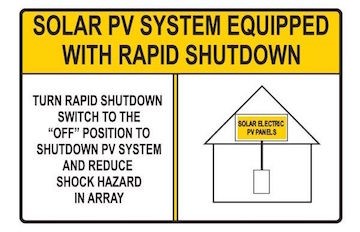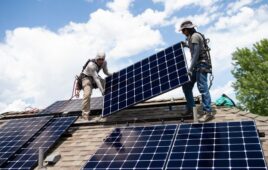 This installation tip was provided by Tiffany Douglass, director of marketing at Tigo Energy
This installation tip was provided by Tiffany Douglass, director of marketing at Tigo Energy
Module-level power electronics (MLPE) are the perfect solution for complying with NEC rapid shutdown requirements. First, MLPE are capable of meeting both NEC 2014 and new NEC 2017 rapid shutdown codes. As of January 1, 2019, NEC 2017 requires that rooftop PV systems’ conductors within an array’s 1-ft boundary must be reduced to 80 V or less within 30 seconds of rapid shutdown initiation. This update calls for module-level rapid shutdown of solar systems instead of NEC 2014’s array-level shutdown requirement.
MLPE add-on/retrofit models or module-integrated “smart modules” are ideal for meeting NEC 2017 as string-level shutdown solutions alone are not sufficient to limit voltage within the 1-ft array boundary. Integrated smart modules reduce installation time for meeting NEC requirements. Plus, with the ability to add functionality, such as module-level monitoring, to reduce maintenance time and optimization to increase energy yields, MLPE bring the option of adding more features as needed.
 When installed according to manufacturer guidelines, the standard practice of shutting down AC power to PV systems prior to safety and maintenance activity on arrays does not change with MLPE. When MLPE equipment and inverters receive AC power from the same breaker and that breaker is shut down, MLPE drop the outputs of all module leads to ensure the array remains below code-specified voltage limits within 30 seconds. In addition to this automatic shutdown function under AC loss, some MLPE also provide manual activation of rapid shutdown features specifically for maintenance purposes.
When installed according to manufacturer guidelines, the standard practice of shutting down AC power to PV systems prior to safety and maintenance activity on arrays does not change with MLPE. When MLPE equipment and inverters receive AC power from the same breaker and that breaker is shut down, MLPE drop the outputs of all module leads to ensure the array remains below code-specified voltage limits within 30 seconds. In addition to this automatic shutdown function under AC loss, some MLPE also provide manual activation of rapid shutdown features specifically for maintenance purposes.
With the latest NEC compliance, manual and automatic shutdown activation and additional features, rapid-shutdown-compliant MLPE can greatly increase peace of mind and ease for safety personnel, solar system owners and installers alike.





I need to retrofit my system: to NEC 2017
Can I add rapid module shut down?
I currently have have 38 of model: JAP6-72-285 JA Brand solar panel. AND SMA SunnyBoy model: SB 10000TLUS-12 AND Tyco Electric Solar Distribution Boxes 1000V 20A